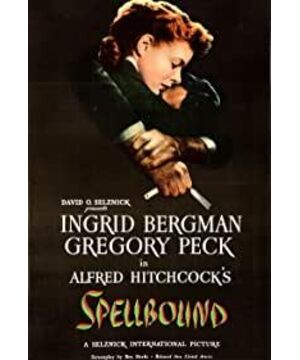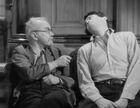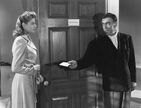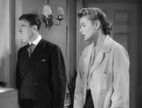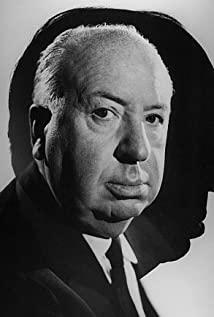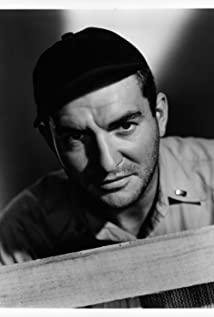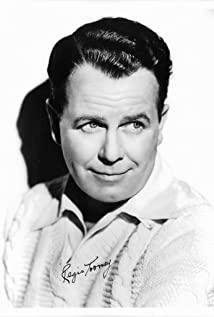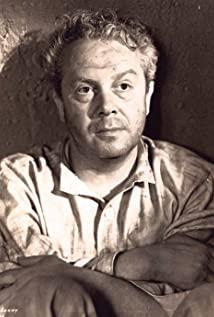The story told in the film is actually not complicated. The director of the mental hospital, Dr. Murchison, is about to retire, and the young and promising Dr. Edward will take his place. The young Dr. Peterson falls in love with him at first sight. But Dr. Peterson soon found out that he was an impostor psychopath, he had severe amnesia, he didn't even know who he was, only a cigarette case with JB on it could prove his identity, he even He also fantasized that he was the murderer of Dr. Edward. In order not to cause trouble to Dr. Peterson, JB escaped from the nursing home and moved into the Imperial Hotel in New York under the pseudonym John Brown. Peterson believed that he was innocent. In order to relieve his criminal complex, she went to the hotel to find him, Together, they avoided the police and hid at the house of her teacher, Professor Erickson. In the middle of the night, JB's condition relapsed, and the old professor asked him to drink milk with sedatives to make him fall asleep peacefully. The next day, by analyzing his dreams, they unraveled his deep-seated criminal complex. Dr. Peterson also analyzed from his dreams and Dr. Murchison's gaffes that the real murderer was Dr. Murchison. It turned out that he murdered Dr. Edward because of jealousy, and finally Dr. Murchison pleaded guilty. , committed suicide.
Psychoanalysis was created by the Austrian psychiatrist Freud, and its psychoanalytic theory mainly includes three parts: the psychological structure theory of subconscious action, the theory of pansexuality and the theory of dreams. Through his own research, Freud rejected the traditional psychological concept of "psychological is conscious". He divided people's psychological structure into three levels: conscious, preconscious and subconscious (or unconscious, subconscious). Compared with previous psychologists who paid more attention to human consciousness, Freud believed that the subconscious mind plays a more important role in human mental activities.
The core of "Dr. Edward" is the "criminal complex", which mainly shows Freud's theory of the unconscious and the theory of dreams.
The theory of the unconscious is Freud's original creation and the core of psychoanalytic theory. Its contribution lies in showing the complexity and hierarchy of human psychology, guiding people to pay attention to the motives before and after consciousness, and to explore the effect of unconscious psychology on human behavior. Influence.
As the director put it in Peterson's words: "People sometimes feel guilty about things they didn't do, it goes back to their childhood. Children always want bad things to happen to them. People who don't like it, but when it does happen, they think it's their own fault, it's a crime complex, but it's just a child's nightmare." As the film shows, when Peter When Sen found JB's inexplicable agitation, nervousness, and panic about things like white colors, lines, train tracks, etc., she thought there must be a terrible secret hidden in his subconscious. He brought back the world of consciousness and gave him psychological treatment, then his disease could not be cured, his true self could not be restored, and ultimately the psychological trauma caused by the murder of Dr. Edward could not be avoided. In the end, with the belief and dedication to his lover, Peterson successfully restored JB's memory with the help of Professor Erickson, revealed the secrets in his subconscious, and found out that he was injured because of his childhood accidental injury to his younger brother. Severe mental trauma, resulting in a strong sense of guilt and guilt. This guilt is suppressed in the subconscious, which leads to JB's constant criminal complex.
The theory of dreams is another important part of Freud's psychoanalytic theory, the main point of which is that many human desires, especially desires, are suppressed into the unconscious because they are inconsistent with social moral standards, so in sleep , when the inspection function is relaxed, it sneaks into the level of consciousness with various disguised images, thus becoming a dream. In other words, because people's desires are not satisfied in real life, they take a roundabout way to manifest in dreams. According to Freud, the essence of the dream "is the (disguised) satisfaction of a (repressed, repressed) wish". Since the dream represents the suppressed instinctual desire, it must take the form of disguise, so the content of the dream is divided into two parts: "appearing content" and "potential thought". The apparent content is the image or event in the dream that we remember. , latent thoughts are the desires that lie beneath those images or events. Freud believed that dreams have four modes of action, namely "compression", "transplantation", "means of expression" and "secondary processing". The so-called compression, that is, multiple potential ideas are compressed into one image. This hybrid dream image is formed to reveal as much content as possible. The so-called transplant is to transplant the focus or center of the underlying thoughts of the dream, and replace the important with the unimportant. The means of expression is to express the thoughts of the dream with concrete images. Since dreams mainly express suppressed sexual desires, the images in dreams are mostly related to sex. Secondary processing is to process the messy material in the dream into a nearly coherent plot.
JB's dream in the film is a good example of Freud's four modes of action on dreams. JB's dream is a bizarre murder case. The actual plot is actually quite complicated. However, all this is displayed in the dream and is simply compressed into three images, namely the quarrel between Murchison and Edward in the casino, the quarrel between Murchison and Edward in the casino, the Killed Edward at the ski resort and JB, who witnessed the murder, fled in a hurry. These fragments are obviously abbreviated translations of JB's dream, which is not just the actual representation of the dream, but compressed, showing the general outline of the dream with several important and specific images. Regarding the transplant, which is reflected in the dream, the irrelevant 7 of the club is used to represent the 21 club, and the white wheel is used to represent the pistol. Obviously, these two factors play a vital role in the case, but they are reflected in the dream and transplanted to two very unimportant elements, showing the real situation in a hidden way. As for the means of expression, we can also find specific expressions in dreams. For example, when JB witnessed the murder process and escaped, a huge wing constantly forced him and chased him. This is the infinite fear in his heart. The image is manifested. Through Peterson and Erickson's interpretation of JB's dream, we can know that because Dr. Murchison could not accept Dr. Edward's replacement, he rushed to the 21 club to accuse Dr. Edward of taking his place. This is a realistic scene. Reflected in the dream, the casino owner accused Dr. Edward of cheating at the gaming table, which was the result of JB's secondary processing of his dream.
As one of the first films in the history of film to focus on psychoanalytic theory, "Dr. Edward" shows us the essence of Freud's psychoanalytic theory as mentioned above, whether from the perspective of knowledge popularization (The film teaches us the knowledge of psychoanalytic theory through the example of two patients at the beginning), it is also the first of its kind of psychoanalytic film, and even the questioning of Freud and the theory of psychoanalysis (the film continues to pass through JB and the patient. The mouth expresses the questioning of Freud), has strong artistic and aesthetic value, no doubt, it is an eternal classic in the history of film.
References:
[1] Ma Xinguo, editor-in-chief, "History of Western Literary Theory" pp. 353~363. Beijing. Higher Education Press. 3rd edition in January 2008
[2] Zhu Liyuan, editor-in-chief, "Contemporary Western Literary Theory" pp. 59~66. Shanghai. East China Normal University Press. April 2005 2nd Edition (Supplementary Edition)
[3] (United States) Gurling, Reber, etc. Author, "Handbook of Literary Criticism Methods" pp. 163~209. Shenyang. Chunfeng Literature and Art Publishing House. 1st Edition in October 1988
[4] (Ao) Freud, "Introduction to Psychoanalysis". Beijing. Commercial Press Library, 2009
[5] Liu Yuebing. Psychoanalytic Psychology on the Screen: On the Significance of the Film "Dr. Edward" [J]. Film Review, 2010, (8).
[6] Cui Yunwei. "Dr. Edward" Psychoanalysis On [J]. Journal of Puyang Vocational and Technical College, 2009, (5).
[7] Liu Jun. Dr. Edward [J]. Film Literature, 2001, (6).
[8] Vivian. Good night, be good Dream[J]. China Health Monthly, 2003, (8).
View more about Spellbound reviews


